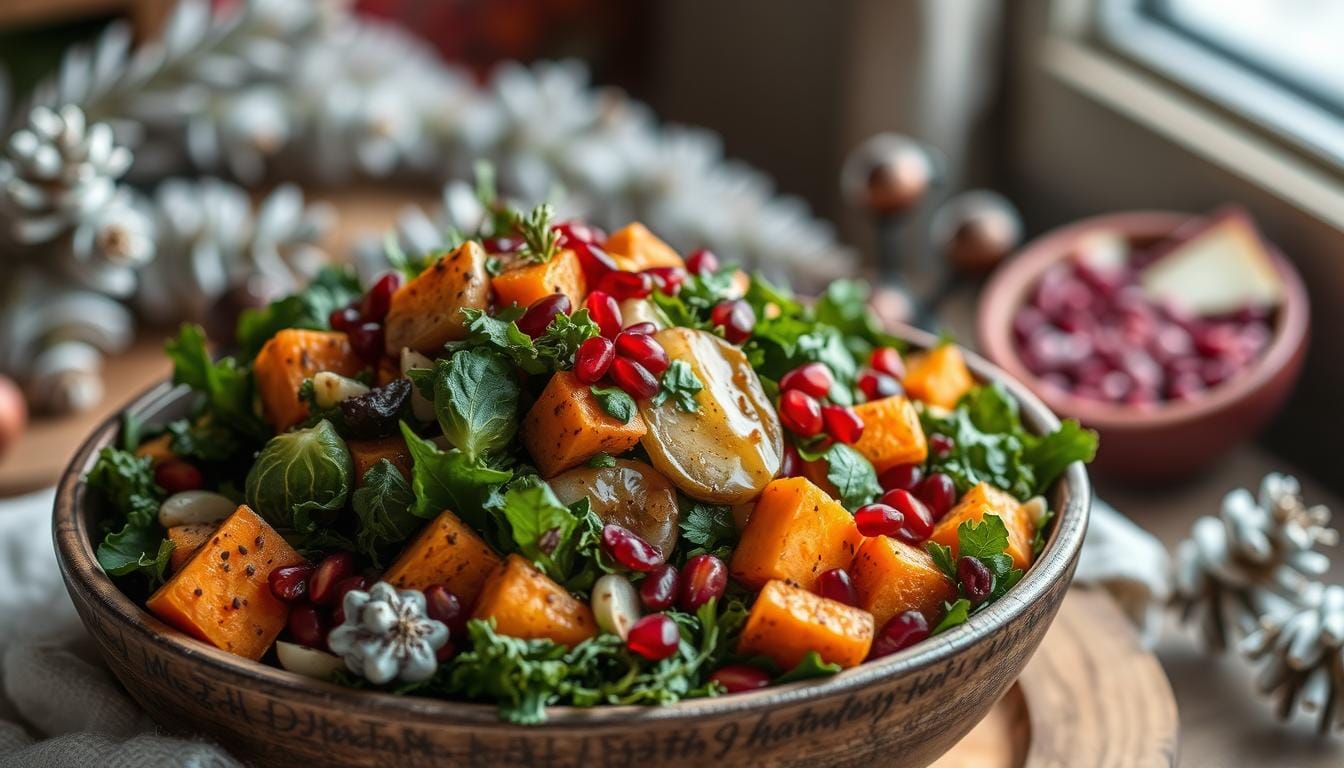Delicious Winter Salad Recipe: Healthy & Flavorful
When winter comes, your kitchen becomes a cozy place. A winter salad is more than a meal. It’s a colorful celebration of the season’s best vegetables.
Imagine making a stunning salad in just 20 minutes. This recipe serves 8 and is full of flavor. Each serving has about 415 calories of deliciousness.
Winter salads are not just healthy. They’re a canvas for seasonal produce. Mix greens, sweet pears, crunchy pecans, tangy cranberries, and creamy blue cheese create a feast for your taste buds.
Your winter salad can be your own masterpiece. Add roasted sweet potatoes, pomegranate seeds, or brussels sprouts. Try different greens like arugula, kale, or spinach for variety.
Get ready to make your winter meals exciting with this simple yet elegant salad. It shows that healthy recipes can be both tasty and fun.
Table of Contents
Understanding the Appeal of Winter Salads
Winter might seem like an unlikely season for salads, but cold weather salads offer a vibrant and nutritious dining experience. As temperatures drop, your approach to salads can transform, creating delightful dishes that warm both body and soul.
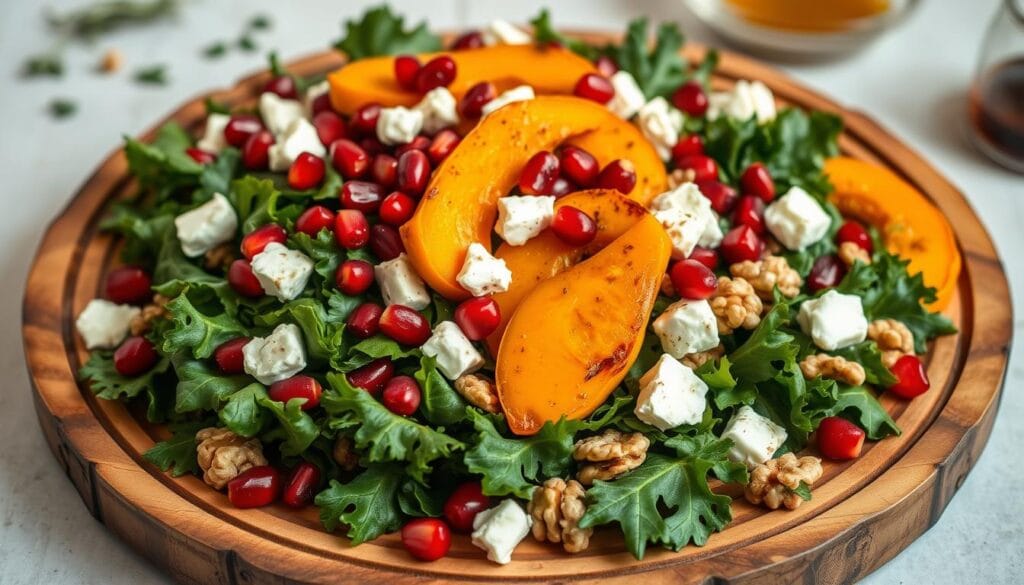
Exploring winter produce reveals a treasure trove of unique ingredients that can elevate your nutrient-rich salads. Unlike summer salads that rely on light, crisp vegetables, winter salads embrace heartier components that provide substance and depth.
Benefits of Eating Fresh Seasonal Produce
Seasonal eating brings multiple advantages to your winter diet:
- Maximizes nutritional value of fresh ingredients
- Supports local agricultural communities
- Ensures more flavorful and vibrant dishes
- Reduces carbon footprint from long-distance food transportation
Why Winter Salads are Different
Winter salads distinguish themselves through unique characteristics. They often incorporate:
- Roasted root vegetables
- Cooked grains like quinoa or barley
- Robust greens such as kale and Swiss chard
- Warming spices and herbs
“Winter salads are not just meals, they’re a celebration of seasonal abundance.”
Nutritional Value in Cold Weather
Cold weather salads pack a powerful nutritional punch. They deliver essential vitamins and minerals that are vital during winter. Root vegetables, winter squash, and hearty greens add nutrients like vitamin C, fiber, and antioxidants.
By embracing winter produce, you transform simple salads into delicious, health-promoting meals that nourish and satisfy.
Essential Winter Salad Ingredients
Making tasty salads means knowing the right mix of fresh ingredients. Winter has special produce that makes salads stand out. These ingredients add warmth and nutrition to your meals.
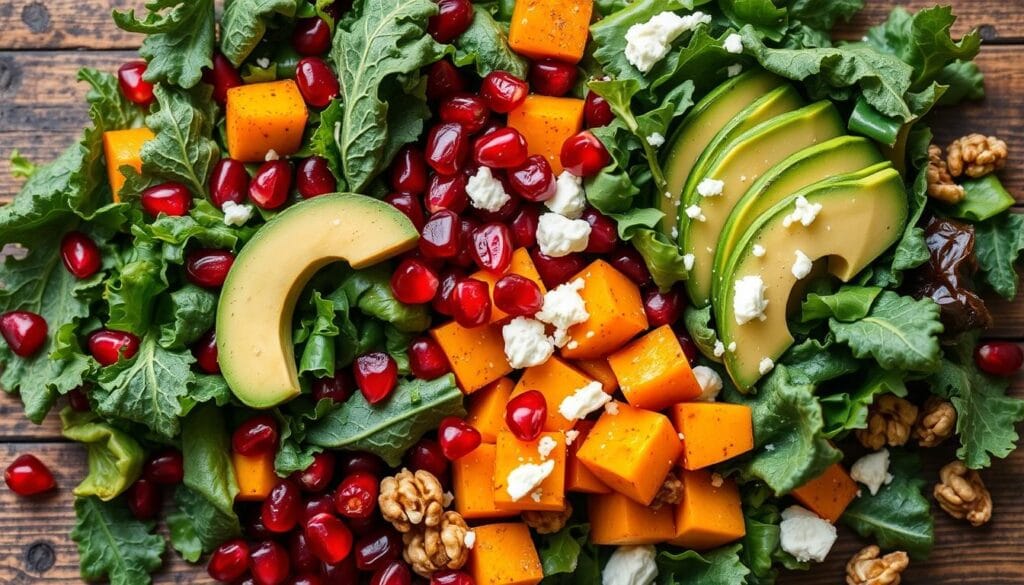
Start with hardy greens that can handle cold. Here are some great choices:
- Kale – packed with nutrients and texture
- Radicchio – adds vibrant color and slightly bitter taste
- Escarole – delicate yet sturdy green
- Romaine lettuce – crisp and refreshing base
Root vegetables add depth to salads. They’re good for the earth and taste amazing:
- Carrots – sweet and crunchy
- Beets – rich in antioxidants
- Radishes – peppery and crisp
- Celery hearts – light and aromatic
To make your salad even better, add protein and texture:
- Roasted chickpeas
- Toasted walnuts
- Sunflower seeds
- Goat cheese or cheddar cheese crumbles
“A great salad is not just about ingredients, but about creating a symphony of flavors that dance on your palate.” – Culinary Expert
| Ingredient Category | Nutritional Highlights | Flavor Profile |
|---|---|---|
| Hardy Greens | High in Vitamins A, C | Robust, slightly bitter |
| Root Vegetables | Rich in Fiber, Minerals | Sweet, earthy |
| Protein Additions | Protein, Healthy Fats | Crunchy, nutty |
Adding seasonal herbs like sage and spices like cinnamon makes your salad special. Each bite is a journey through winter’s flavors.
Seasonal Vegetables for Your Winter Salad
Winter produce brings a variety of hearty salads to warm up your meals. Finding the right seasonal vegetables can turn a simple salad into a feast. Let’s look at the amazing options that make your salad both healthy and tasty.
Root Vegetables: Winter’s Hidden Gems
Root vegetables shine in salads, adding deep flavors and firm textures. Here are some top picks:
- Beets: Vibrant and earthy, perfect for roasting
- Carrots: Sweet and crunchy when shaved or roasted
- Parsnips: Slightly nutty with a creamy texture
- Turnips: Crisp and mildly peppery
Hardy Greens: Sturdy and Nutritious
Hardy greens are the backbone of winter salads. They’re tough enough for cold weather and full of nutrients:
- Kale: Packed with nutrients and holds dressing well
- Collard greens: Tender when massaged
- Brussels sprouts: Delicious when shredded raw
- Radicchio: Adds a peppery kick
Winter Squash Varieties: Sweet and Satisfying
Winter squash adds natural sweetness and a hearty texture to salads. Roasting them brings out their flavor, making your salad even better:
- Butternut squash: Creamy and rich
- Acorn squash: Nutty and tender
- Delicata squash: Easy to prepare with edible skin
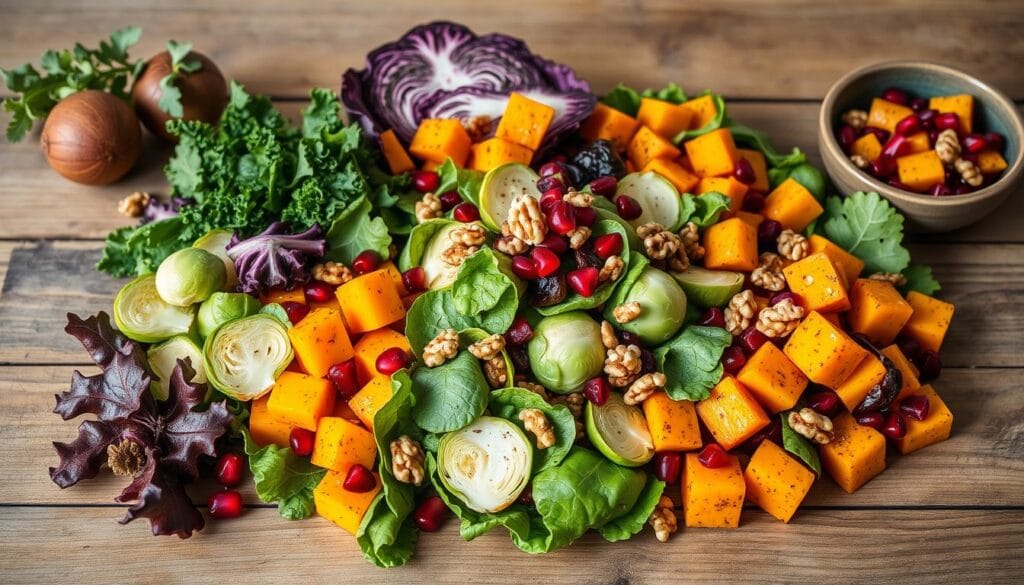
“The secret to a great winter salad is embracing the unique qualities of seasonal vegetables.” – Culinary Expert
Pro tip: Try roasting, shaving, or eating these vegetables raw. You’ll find new textures and tastes in your hearty salads.
The Perfect Base: Choosing Your Greens
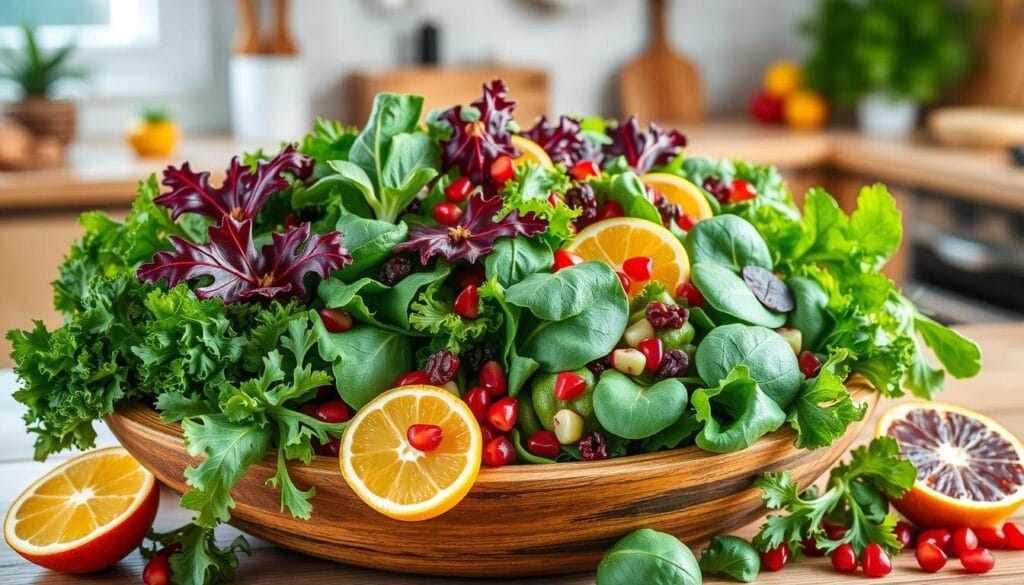
Starting a delicious salad means picking the right greens. Kale is a top choice, packed with nutrition and versatility. Its strong texture is perfect for winter salads.
Here are the best greens for your winter salad:
- Kale (most recommended)
- Spinach
- Arugula
- Mixed lettuce varieties
For kale, try this trick: massage the leaves with lemon juice and olive oil. It makes the kale softer and less bitter, making your salad better.
“The key to a great salad is in the greens you choose” – Culinary Experts
Each green adds something special to your salad. Mixing them can make your salad taste and look better. Arugula gives a peppery flavor, while baby spinach is tender and mild.
| Green Type | Flavor Profile | Nutritional Highlight |
|---|---|---|
| Kale | Robust, slightly bitter | High in vitamins K, A, C |
| Spinach | Mild, smooth | Rich in iron and folate |
| Arugula | Peppery, sharp | Packed with calcium |
Choosing the right greens can turn a simple salad into a memorable winter salad experience.
Adding Protein and Texture Elements
Creating hearty salads in winter needs careful ingredient choice. The right mix of protein, crunch, and texture turns a simple salad into a fulfilling meal. It pleases your taste buds and feeds your body well.
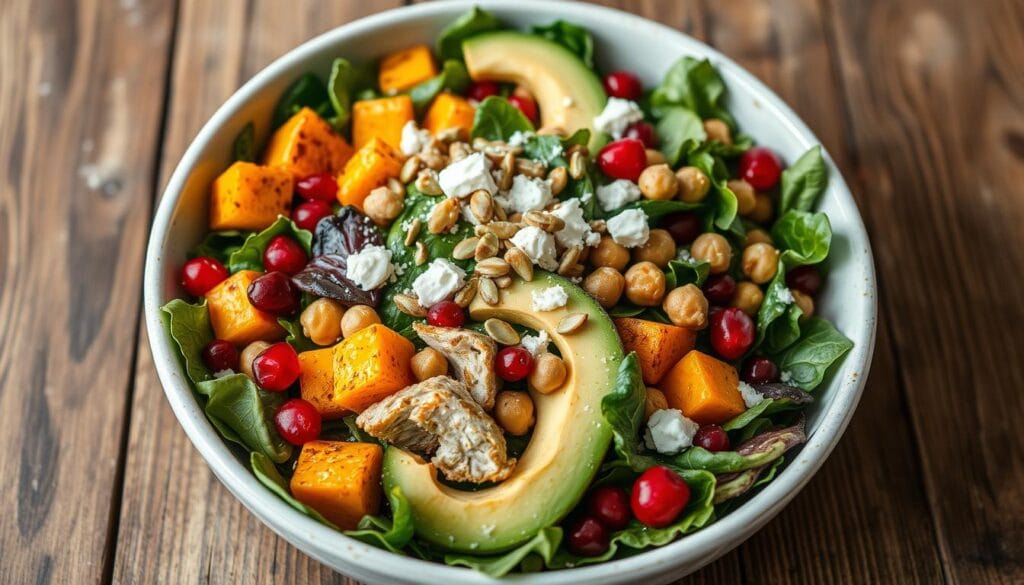
Nuts and Seeds: Crunchy Nutrition Boosters
Winter salads get a boost from nuts and seeds. Here are some tasty choices:
- Toasted pecans for rich, buttery flavor
- Crunchy pumpkin seeds for added minerals
- Pistachios for vibrant green color and protein
- Sunflower seeds for a subtle nutty taste
Protein-Rich Additions That Satisfy
Make your salads more filling with protein-rich ingredients:
- Grilled chicken breast
- Roasted chickpeas
- Crumbled feta cheese
- Soft-boiled eggs
- Marinated tofu cubes
Crunchy Toppings for Texture
Texture is essential for memorable salads. Try these crunchy toppings:
- Crispy roasted chickpeas
- Homemade herbed croutons
- Caramelized onion crisps
- Toasted breadcrumbs
“A great salad is all about balance – combining flavors, textures, and nutritional elements to create a truly satisfying dish.”
The aim is to make hearty salads that are both healthy and exciting. Try different mixes to discover your favorite winter salad.
Winter Salad Dressing Combinations
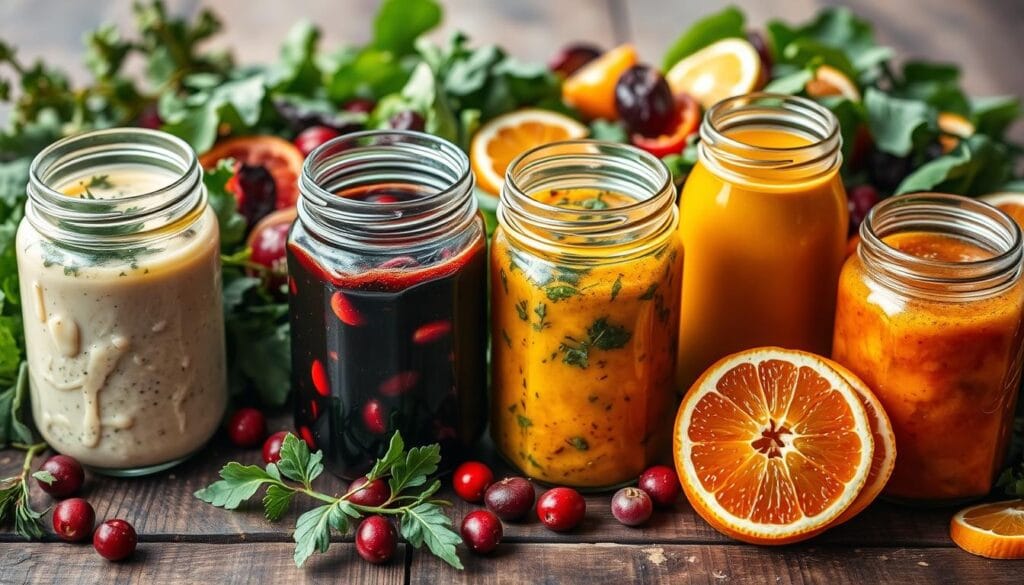
Making the perfect winter salad dressing can take your healthy recipes to the next level. The right dressing adds depth and complexity to your winter salad. It makes the flavors pop.
Try these amazing dressing combinations to warm up your winter salad:
- Maple-Mustard Vinaigrette: A classic winter favorite combining sweet maple syrup, tangy red wine vinegar, and robust mustard
- Creamy Tahini Dressing: Rich and nutty, perfect for adding protein and depth to leafy greens
- Citrus-Infused Olive Oil Dressing: Bright and refreshing, using extra-virgin olive oil and fresh citrus juice
Your winter salad dressing should balance flavors and match seasonal produce. Greek yogurt-based dressings are creamy and healthy. They’re a great choice for a guilt-free dressing.
“The secret to an amazing winter salad is a dressing that tells a story of seasonal ingredients.”
Here are some pro tips for making unforgettable winter salad dressings:
- Always use fresh, high-quality ingredients
- Shake dressings vigorously to blend flavors
- Taste and adjust seasonings before serving
Don’t be afraid to mix things up. Try apple cider vinegar, honey, and fresh herbs. They’ll create unique winter salad experiences that will wow your taste buds.
Step-by-Step Preparation Guide
Making a tasty winter salad needs careful prep and detail. This guide will help you make a healthy and tasty winter salad. It will wow your family and friends.
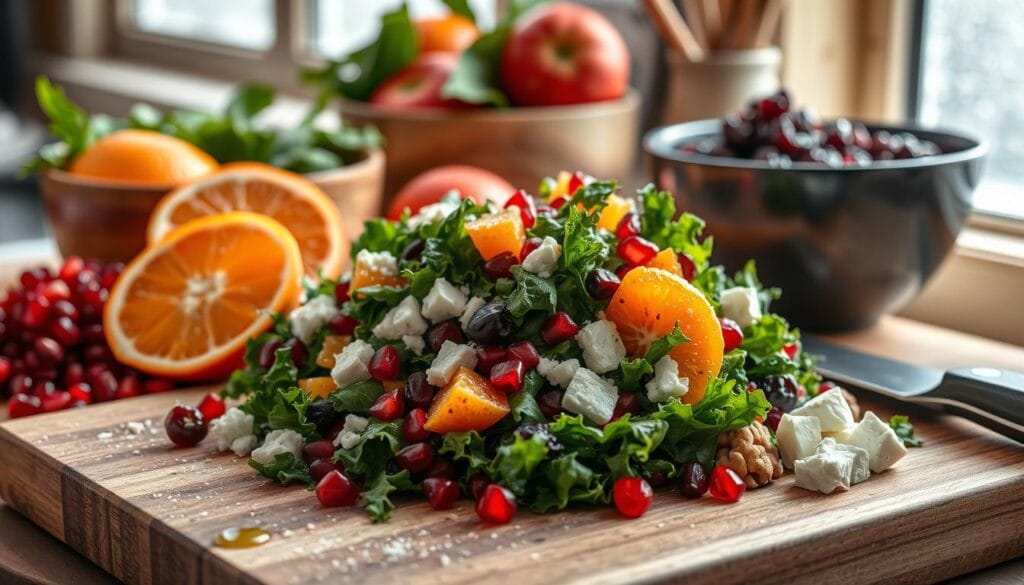
Creating a winter salad involves several key steps. These steps ensure your salad tastes great and feels good in your mouth. Let’s go through each step.
Prepping the Vegetables
Begin by picking fresh, top-notch winter veggies. For your salad, follow these prep tips:
- Wash all veggies well to get rid of dirt and bits
- Use a sharp knife to cut veggies into small, easy-to-eat pieces
- Peel root veggies like butternut squash carefully
- Chop kale into thin strips for better texture
Roasting Techniques
Roasting turns winter veggies into sweet, flavorful pieces for your salads:
- Heat your oven to 425°F
- Toss butternut squash cubes with olive oil and spices
- Put veggies in a single layer on a baking sheet
- Roast for 25-30 minutes, flipping halfway
Assembly Instructions
The last step is to layer and mix your ingredients carefully:
- Begin with a base of mixed greens like kale and arugula
- Add roasted veggies for warmth and flavor
- Sprinkle nuts like pistachios for crunch
- Crumble vegan feta for a creamy touch
- Drizzle homemade dressing just before serving
Pro tip: Massage kale with a bit of lemon juice to soften it and cut bitterness.
Follow these steps to make a delicious and healthy winter salad. It will highlight the best of the season’s flavors.
Make-Ahead Tips and Storage
Creating tasty winter salads doesn’t have to take all day. With a few smart tips, you can make healthy meals quickly and keep them delicious.
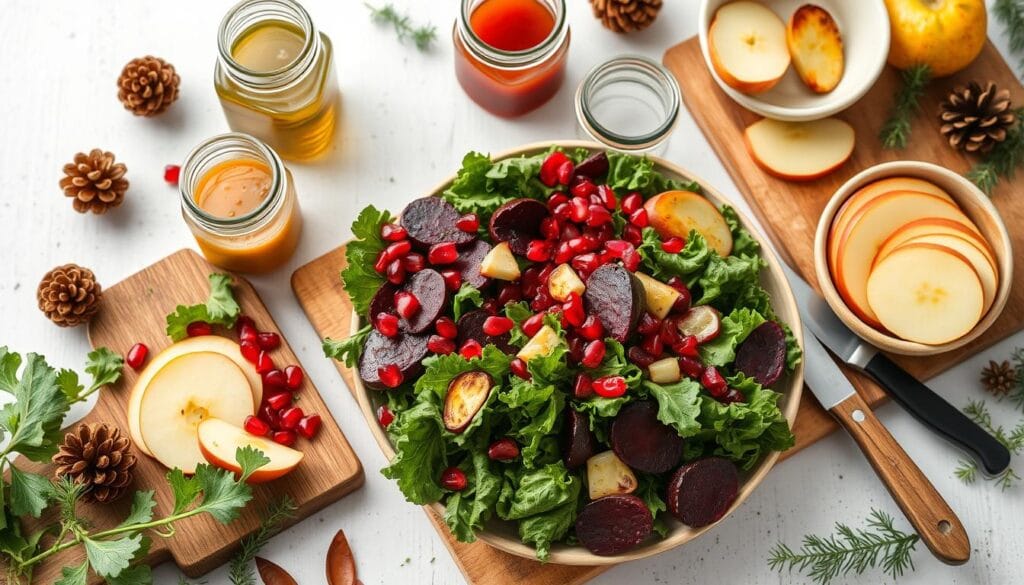
When meal prepping winter salads, pick your ingredients wisely. Some parts can be made ahead, while others need to be done just before serving.
Advance Preparation Guidelines
- Roast root vegetables up to 3 days ahead
- Cook grains like farro and quinoa in bulk
- Prepare dressings and store in sealed containers
- Chop hardy vegetables in advance
Storage Recommendations
| Ingredient Type | Make-Ahead Potentia | Storage Duration |
|---|---|---|
| Sturdy Greens (Kale) | Can be dressed day before | 24-36 hours |
| Delicate Greens | Dress just before serving | Same day |
| Roasted Vegetables | Fully preparable in advance | 3-4 days |
Pro tip: Keep crunchy elements like nuts and seeds separate until serving to maintain optimal texture in your winter salad ideas.
“Preparation is the secret ingredient in creating memorable, healthy recipes.” – Culinary Expert
Refrigeration Best Practices
- Store components separately in airtight containers
- Keep dressings in glass jars with tight lids
- Refrigerate prepared ingredients at 40°F or below
- Consume prepared salad components within 3-4 days
By using these make-ahead tips, you’ll make winter salad prep quick and fun.
Seasonal Variations and Substitutions
Creating versatile winter salad ideas means embracing flexibility with seasonal vegetables. Your winter salad can easily transform based on ingredient availability and personal dietary preferences.
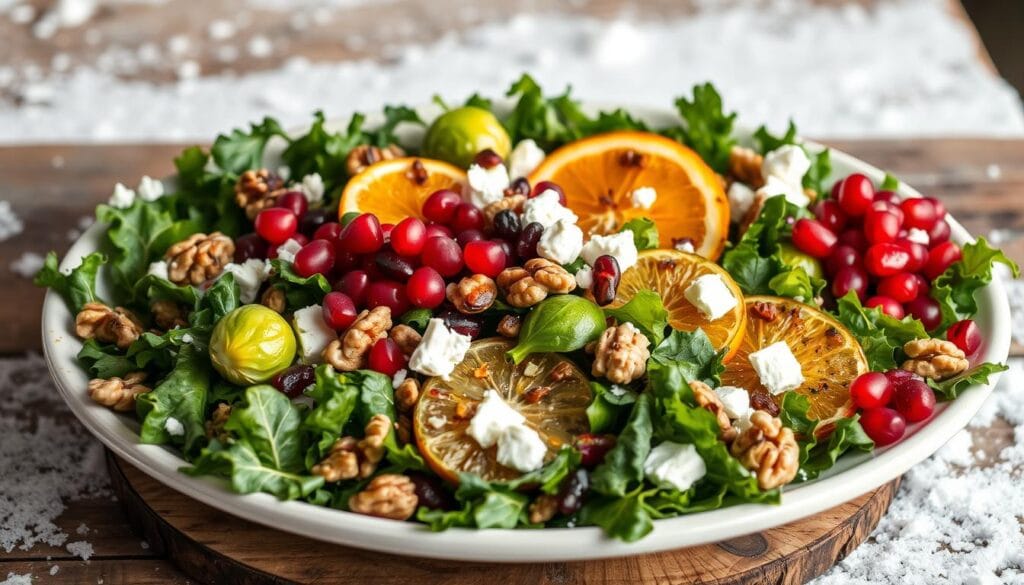
Winter salads offer incredible adaptability, allowing you to customize every element of your dish. The key is understanding how different ingredients can work together while maintaining nutritional value.
Alternative Ingredient Options
- Replace butternut squash with roasted sweet potatoes
- Swap nuts with seeds for allergy-friendly versions
- Use plant-based proteins like tempeh or tofu
- Experiment with different seasonal vegetables
Dietary Modification Strategies
Your winter salad can accommodate various dietary needs with simple ingredient swaps:
| Dietary Requirement | Substitution |
|---|---|
| Vegan | Use maple syrup instead of honey, omit cheese |
| Gluten-Free | Choose quinoa or mixed greens as base |
| Nut-Free | Replace nuts with sunflower or pumpkin seeds |
“Creativity in the kitchen begins with understanding how ingredients can be transformed.” – Seasonal Cooking Expert
Remember that winter salad ideas are all about embracing seasonal vegetables and personalizing your culinary experience. With these variations, you can craft a nutritious and delicious salad that suits your taste and dietary requirements.
Pairing Suggestions and Serving Ideas
Turn your winter salad into a main event with clever pairings. Your hearty salads can make any meal special with the right serving ideas.
Here are some ways to wow your family and guests with your winter salad:
- Pair with warm proteins like roasted chicken or grilled salmon
- Complement with crusty artisan bread for added texture
- Serve alongside robust soups for a complete winter meal
Presentation Tips
Visual appeal is key when serving your winter salad. Use a large, shallow bowl to highlight the colors of your ingredients. Add warm roasted veggies or grilled proteins on top for a stunning look.
| Ingredient | Pairing Suggestion | Flavor Profile |
|---|---|---|
| Roasted Root Vegetables | Grilled Chicken | Hearty and Warm |
| Frisée Greens | Goat Cheese | Tangy and Fresh |
| Toasted Nuts | Aged Cheddar | Rich and Crunchy |
Your winter salad can be more than just a side dish. With creative pairings and careful preparation, it becomes a highlight that pleases the taste buds and warms the heart.
“A great salad is not just about ingredients, but about creating a symphony of flavors and textures.”
Pro tip: Mix warm and cool elements in your winter salad for a memorable meal. Try different combinations to find your favorite winter salad pairing.
Conclusion
Your winter salad journey is full of nutritional wonders. Seasonal veggies turn simple meals into special treats that feed both body and soul. By trying out different winter salad recipes, you’ll see how easy it is to make tasty, healthy dishes.
Healthy winter salads with greens like kale, spinach, and Swiss chard give you the energy you need. Services like 5amfresh.com make it easy to get fresh, quality produce. This means you can make delicious winter salads right at home.
Exploring roasted veggies, citrus fruits, and unique dressings will make you love winter food more. Your winter salad can be a place for creativity. It’s a mix of nutrition, taste, and beauty, all celebrating the season.
Every winter salad is a chance to strengthen your immune system and enjoy great flavors. With the right ingredients and a little creativity, you can turn cold-weather meals into something amazing.

